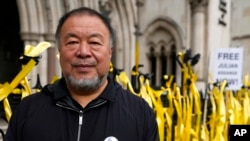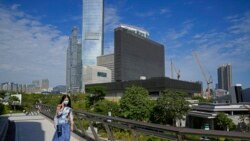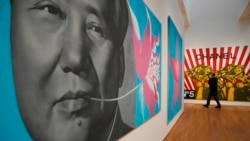Art censorship in Hong Kong is “very much real,” an expert said after the city’s much-anticipated art gallery opened recently without showcasing some expected artworks by a Chinese dissident.
The former British colony’s largest art museum, M+, opened Nov. 12 to great fanfare, but also heated debate because of its failure to exhibit two of famous exiled artist Ai Wei Wei’s artworks in a donated collection of celebrated Swiss art collector Uli Sigg.
Among the collection of contemporary Chinese art from the 1970s to the 2000s, Ai’s Study of Perspective: Tiananmen, a photo that features Ai’s middle finger in front of Beijing’s Tiananmen Square, and Map of China, a sculpture made of salvaged wood from a Qing Dynasty temple, have been under review by authorities since March this year, essentially barring them from display.
That came two weeks after M+ director Suhanya Raffel guaranteed that the gallery would show Ai’s art and pieces about the 1989 Tiananmen crackdown, according to The South China Morning Post.
In the same month, Hong Kong’s leader Carrie Lam said the authorities would be on “full alert” to ensure museum exhibitions would not undermine national security, after pro-Beijing lawmakers said the artworks at M+ caused “great concerns” to the public for “spreading hatred” against China, public broadcaster RTHK reported.
In a September editorial in local media outlet Stand News, Ai called the government’s decision to shelve his two pieces “incredible.”
“The Study of Perspective series I started at Tiananmen Square 26 years ago once again became the testing ground for an important change in history, and a convincing note for China’s political censorship of its culture and art,” Ai wrote. Other images in the series featured the middle finger in front of the White House, the Swiss parliament and the Mona Lisa.
Sigg donated over 1,400 artworks and sold 47 pieces to M+ gallery in 2012, before the city experienced political turmoil from the 2014 Occupy Central movement, the 2019 anti-government protests and implementation of the controversial national security law last year.
Sigg originally wanted to make mainland China home to his collection, but no art galleries there could ensure that his artworks, including Ai Wei Wei’s, would be displayed without restriction, according to SOAS University of London art history professor Shane McCausland.
“Hong Kong’s legal framework at the time promised that these artworks could be shown…[but] policy on display will have changed dramatically after the national security law came in,” McCausland told VOA.
The head of the West Kowloon Cultural District, Henry Tang, said ahead of the M+ gallery opening that the board would “uphold and encourage freedom of artistic expression and creativity,” but added that the opening of M+ “does not mean artistic expression is above the law.” He also denied that the two artworks put under review meant they were illegal.
However, such an ostensibly normal bureaucratic act from the government is China’s usual form of censorship, McCausland said.
“It’s often unclear even to the initiated, where the boundary lies, as it moves all the time. The laws are framed in vague language: they often appear to be applied arbitrarily and randomly. …The application depends on the [Chinese] leadership from the top, where there is a degree of sensitivity to criticism and intolerance of critiques,” he said.
The city’s freedom of artistic expression has been declining since the national security law took effect last year, according to a local independent performance and dance artist who asked that she only be identified by her initial, “V.”
“This [the ban] did not come as a surprise - some artists’ works that might be considered sensitive are not allowed to display recently after the national security law was out, not to mention M+ is a government venue,” V told VOA.
Self-censorship has become a norm in Hong Kong’s art circles, V added.
“The atmosphere has been rather tense. Some movie screenings had to be canceled. Now we still want to voice out our views, but we start thinking about if we should express in a very edgy way, or if politics is the only way for us to express,” she said.
A new film censorship law came into effect in November that aims to “prevent and suppress acts or activities that may endanger national security.”
The supposedly autonomous region is now on track to mirror mainland China’s propaganda and censorship, McCausland said.
“Essentially Hong Kong is poised to become very similar to the framework within the rest of China, with artists being vigilant and constantly watching the moving sense of what’s OK and becoming attuned to when the likelihood is high of the system kicking in with legal ramifications, such as house detention or other judicial options that are open to the authorities, which they are happy to use to ensure the public discourse of harmony,” he said.
Growing art censorship is expected to intensify the talent drain in Hong Kong, which has witnessed an exodus to Western countries, including Britain and Canada, since the start of the 2019 anti-government protests, the art expert said.
“We know there was an astounding majority in favor of democracy - the views of the people were very clear but now you are hearing and seeing the space for expression has been closed down, and often in a heavy-handed way,” McCausland said.
The University of Hong Kong, one of Hong Kong’s most prestigious educational institutions, has ordered the removal of a sculpture commemorating the student victims of the Tiananmen crackdown since October. The university cited “the latest risk assessment and legal advice” as the reason for the request to take away the iconic statue that has been in place for the last 24 years.
“Being an ‘artivist’ [activist artist] is not easy anymore - I started thinking about the role I should play in this era. … I can’t say for sure I will go, but some of my artist friends left because funding has become more challenging,” V said.












